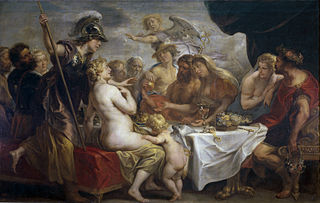
A figure painting is a work of fine art in any of the painting media with the primary subject being the human figure, whether clothed or nude. Figure painting may also refer to the activity of creating such a work. The human figure has been one of the constant subjects of art since the first stone age cave paintings, and has been reinterpreted in various styles throughout history.

Vlaho Bukovac was a Croatian painter and academic. His life and work were eclectic, for the artist pursued his career in a variety of locales and his style changed greatly over the course of that career. He is probably best known for his 1887 nude Une fleur, which he created during his French period and which received attention in various reviews and publications during his lifetime. Bukovac was the court painter for Obrenović dynasty, Karađorđević dynasty and Petrović-Njegoš dynasty. In Zagreb, he is probably best known as the painter of the 1895 theatre curtain in the Croatian National Theatre.

Mirko Rački was a Croatian painter.

The White Palace is the official residence of the Yugoslav former royal family. It is located within the Royal Compound, in the Dedinje neighborhood of Belgrade.
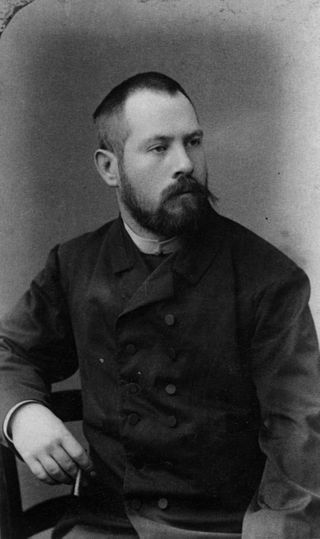
Lovis Corinth was a German artist and writer whose mature work as a painter and printmaker realized a synthesis of impressionism and expressionism.
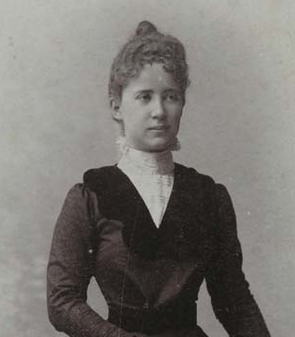
Slava Raškaj was a Croatian painter, considered to be the greatest Croatian watercolorist of the late 19th and early 20th century. Deaf since birth, Raškaj was schooled in Vienna and Zagreb, where her mentor was the renowned Croatian painter Bela Čikoš Sesija. In the 1890s her works were exhibited around Europe, including at the 1900 Expo in Paris. In her twenties Raškaj was diagnosed with acute depression and was institutionalised for the last three years of her life before dying in 1906 from tuberculosis in Zagreb. The value of her work was largely overlooked by art historians in the following decades, but in the late 1990s and early 2000s interest in her work was revived.

Bela Čikoš Sesija was a Croatian Symbolist painter, art teacher and one of the founders of the Academy of Fine Arts in Zagreb.
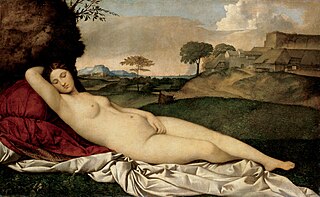
The Sleeping Venus, also known as the Dresden Venus, is a painting traditionally attributed to the Italian Renaissance painter Giorgione, although it has long been usually thought that Titian completed it after Giorgione's death in 1510. The landscape and sky are generally accepted to be mainly by Titian. In the 21st century, much scholarly opinion has shifted further, to see the nude figure of Venus as also painted by Titian, leaving Giorgione's contribution uncertain. It is in the Gemäldegalerie, Dresden. After World War II, the painting was briefly in possession of the Soviet Union.

Cavtat is a village in the Dubrovnik-Neretva County of Croatia. It is on the Adriatic Sea coast 15 kilometres south of Dubrovnik and is the centre of the Konavle municipality.
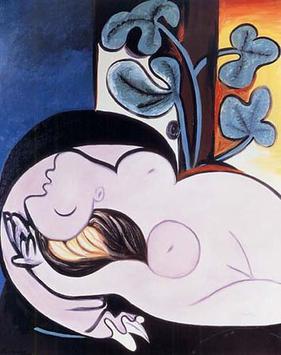
Nude in a Black Armchair is an oil on canvas painting by Pablo Picasso. Painted on 9 March 1932, a time at which Picasso lived in Boisgeloup outside Paris, it is the first and largest of a series of paintings Picasso completed that year of his mistress Marie-Thérèse Walter. The painting was purchased by Les Wexner at Christie's auction in 1999 for the value of $45.1 million.

The Pavle Beljanski Memorial Collection is a public art museum in Novi Sad, Serbia. It displays paintings and sculptures by 20th century Serbian and Yugoslav artists, mostly from the interwar period. The collection bears the name of its founder and contributor Pavle Beljanski, Serbian diplomat and art collector, who donated his collection of paintings, sculptures and tapestries to the Serbian people in November 1957. He continued to add works of art to this significant collection until his death. The collection consists of 185 works by 37 artists. The Pavle Beljanski Memorial Collection was opened to the public on 22 October 1961.

The Art pavilion in Zagreb is an art gallery in Zagreb, Croatia. The pavilion is located on the Lenuci Horseshoe, Lower town area of the city, south of Nikola Šubić Zrinski Square, on the northern side of the King Tomislav Square which flanks the Zagreb Central Station. Established in 1898, it is the oldest gallery in the Southeast Europe and the only purpose-built gallery in Zagreb designed specifically to accommodate large scale exhibitions.

Odalisque With Raised Arms is a painting by Henri Matisse, completed in 1923. The oil on canvas measuring 23 by 26 inches is in the National Gallery of Art, Washington D.C. Matisse's style changed and evolved drastically throughout his career, including a wide and varying collection of paintings depicting the female nude. His Odalisque paintings were inspired by his trip to Morocco. Many of the female subjects in the Odalisque paintings were modeled after Matisse's main model at the time, Henriette Darricarrère.

Croatian art of the 20th century, that is visual arts within the boundaries of today's Croatia, can be divided into modern art up to the Second World War, and contemporary art afterwards.
The Greatest Croatian was an open-access poll conducted over five weeks in 2003 by the Croatian weekly Nacional.

The Museum of Fine Arts, is an art museum in Split, Croatia containing works from the 14th century up to the present day providing an overview of the artistic developments in the local art scene. The museum was founded in 1931, and has a permanent exhibition of paintings and sculptures that includes works by major Croatian artists such as Vlaho Bukovac, Mato Celestin Medović, Branislav Dešković, Ivan Meštrović, Emanuel Vidović and Ignjat Job. The museum also has an extensive collection of icons, and holds special exhibits of works by contemporary artists.

Mato Celestin Medović was a Croatian painter. Best known for his large paintings depicting historical scenes, and his series of colourful landscapes and seascapes of his native Dalmatia, Medović is one of the earliest modern Croatian painters.

Ivan Tišov was a Croatian painter. He studied art at the Academy of Fine Arts, Munich, bringing back ideas from the Munich Secession movement to Zagreb. He is best known for his work in public and government buildings in Zagreb, and paintings in churches in his native Slavonia in north-east Croatia.
Milivoj Uzelac (1897–1977) was a painter influential in the Zagreb modern art scene of the 1920s and 30s. During the Zagreb Spring Salon of the 1920s, he participated with Vilko Gecan, Marijan Trepše and Vladimir Varlaj as the Group of Four. Uzelac spent much of his professional life in France, and is best known for his portraits and interior scenes with bohemian characters.

Pero Popović was a Bosnian Serb painter.


















